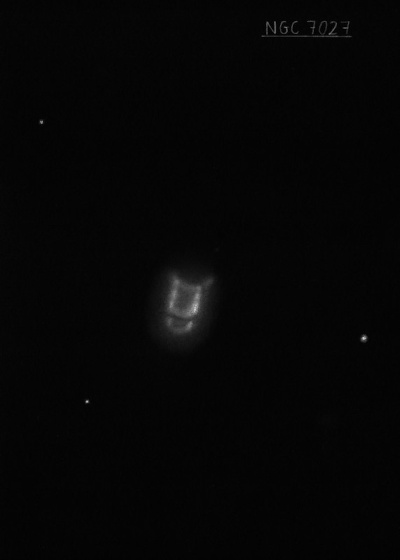
80mm (9/10/07): visible as a mag 8.5-9 "star" at 12.5x in the 80mm finder and easily identified using an OIII blink.
Édouard Stephan discovered NGC 7027 = St IX-27 in the fall of 1878 with the 31-inch Foucault reflector at Marseille. This planetary is probably the brightest object he discovered. From some reason it was not included in Esmiol's 1916 re-reduction of Stephan's positions.
The following observational history is from Wolfgang Steinicke. The Reverend Thomas Webb independently rediscovered NGC 7027 on 14 Nov 1879 using a 9-inch reflector. He described it as an "object like a bluish 9 mag star, not quite of stellar character - a small pair, too close to be separated?" At higher magnifications it was seen as "bright, very ill-defined, nebulous disk of about 4" diameter, surrounded probably by a little glow, and much resembling the planet Uranus." Webb's announcement in several publications created a flurry of interest in late 1879 with spectroscopic observations by Knott, Copeland, Winnecke, Vogel. In 1880, Dreyer noted Stephan's prior discovery, though it was still commonly assumed that Webb was the discoverer. E.E. Barnard observed NGC 7027 in June of 1889 with the Lick 36-inch at 500x (with Burnham) and logged, "In the p part there is a small bluish -green star like object - shining through ? haze. Occasionally a darkish space separates the condensations into two."
Based on Crossley photographs taken at Lick, Heber Curtis (1918) reported "the condensations are not stellar in the shortest exposures. Quite irregular and roughly trinuclear, though the southern condsation is apparently two masses close together. The southern condensation and the brighter at the north are 7.5" apart in p.a. 135°."
300/350mm - 13" (9/11/82): at 288x; small, bright, unusually high surface brightness, elongated NW-SE. There are two distinct overlapping nuclei and a narrow dark lane possibly separates these two condensations.
400/500mm - 17.5" (10/2/99): At 100x, the small greenish disc is very prominent but at higher powers appears bluish. Easily takes very high power and the view unfiltered at 380x and 500x was striking. Appears elongated 3:2 NW-SE, 0.3'x0.2', with two distinct lobes. The NW knot is slightly brighter and at times a stellar spot or star appears embedded at its SW tip. At 500x, the two knots are encased in a very small common halo that extends further out on the north side. The southern edge of both knots has a sharp, flat appearance.
900/1200mm - 48" (10/24/14): this fairly small, ultra-high surface brightness green planetary was observed at 610x. Overall, the object extends ~18"x12" NW-SE, but split up into three distinct components. The first and brightest component is an elongated glow (~10"x6" NW-SE) on the northwest side, which contains a very small, intensely bright knot at its western edge! The second bright component is adjacent to its east and is separated by a thin, darker lane. This section has an elongated, irregular outline (~10"x6" NW-SE), and is slightly mottled with brighter spots. A thin, high-contrast dark lane runs WSW-ENE at the south edge of these two sections. The third bright component, just southeast of this lane, appeared as an irregular, elongated bar, running 2:1 WSW-ENE, ~12"x6" and formed a "cap" on the southeast side. The two ends of this cap are very slightly curved (concave to the northwest).
Notes by Steve Gottlieb